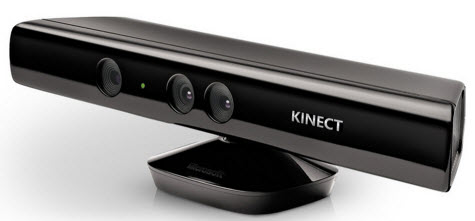
If you haven't heard, Microsoft has released a new version of the Kinect that's just for Windows applications, along with a new Software Development Kit so .NET developers can write apps for Windows that use the Kinect.
Code along with me while I show you how to get started.
Downloads:
This is a 64-bit SDK with a commercial license.
If you're going to use voice recognition with the Kinect, download these:
Download the x86 versions of each of these. Kinect only works with the 32-bit version.
We're going to make an application that simply tracks your right hand, showing the X, Y, and Z values in real-time as you move it.
Getting Started:
- Create a new WPF application
- Add a reference to the Kinect SDK
C:\Program Files\Microsoft SDKs\Kinect\v1.0\Assemblies\Microsoft.Kinect.dll
- If using Speech, add a reference to the Microsoft Speech SDK
C:\Program Files (x86)\Microsoft SDKs\Speech\v11.0\Assembly\Microsoft.Speech.dll
XAML Source:
Change the default <Grid></Grid> to the following:
<StackPanel>
<Label FontSize="30" Content="X" Height="50"
HorizontalAlignment="Left" Margin="10,10,0,0" Name="LabelX"
VerticalAlignment="Top" />
<Label FontSize="30" Content="Y" Height="50"
HorizontalAlignment="Left" Margin="10,10,0,0" Name="LabelY"
VerticalAlignment="Top" />
<Label FontSize="30" Content="Z" Height="50"
HorizontalAlignment="Left" Margin="10,10,0,0" Name="LabelZ"
VerticalAlignment="Top" />
</StackPanel>
VB Source:
Class MainWindow
Private WithEvents Sensor As Microsoft.Kinect.KinectSensor
Private Sub Window_Loaded(sender As System.Object, e As System.Windows.RoutedEventArgs) Handles MyBase.Loaded
If Microsoft.Kinect.KinectSensor.KinectSensors.Count = 0 Then
MessageBox.Show("No Kinect Devices Found")
Application.Current.Shutdown()
Else
Sensor = Microsoft.Kinect.KinectSensor.KinectSensors(0)
Sensor.SkeletonStream.Enable(New Microsoft.Kinect.TransformSmoothParameters)
Sensor.Start()
End If
End Sub
Private Sub Sensor_SkeletonFrameReady(sender As Object, e As Microsoft.Kinect.SkeletonFrameReadyEventArgs) Handles Sensor.SkeletonFrameReady
Dim frame = e.OpenSkeletonFrame
'-- Bail if there's no frame.
If frame Is Nothing Then Return
Using frame
'-- Bail if no data is returned
If frame.SkeletonArrayLength = 0 Then Return
'-- Copy the data to an array
Dim data(frame.SkeletonArrayLength - 1) As Microsoft.Kinect.Skeleton
frame.CopySkeletonDataTo(data)
'-- Bail if the data wasn't copied
If data.Length = 0 Then Return
'-- Are we tracking?
If data(0).TrackingState = Microsoft.Kinect.SkeletonTrackingState.Tracked Then
'-- data(0) now contains live data
Dim X = data(0).Joints(Microsoft.Kinect.JointType.HandRight).Position.X
Dim Y = data(0).Joints(Microsoft.Kinect.JointType.HandRight).Position.Y
Dim Z = data(0).Joints(Microsoft.Kinect.JointType.HandRight).Position.Z
LabelX.Content = X.ToString
LabelY.Content = Y.ToString
LabelZ.Content = Z.ToString
LabelX.UpdateLayout()
LabelY.UpdateLayout()
LabelZ.UpdateLayout()
End If
End Using
End Sub
End Class
C# Source:
public partial class MainWindow : Window
{
Microsoft.Kinect.KinectSensor Sensor;
public MainWindow()
{
InitializeComponent();
if (Microsoft.Kinect.KinectSensor.KinectSensors.Count == 0)
{
MessageBox.Show("No Kinect Devices Found");
Application.Current.Shutdown();
}
else
{
Sensor = Microsoft.Kinect.KinectSensor.KinectSensors[0];
Sensor.SkeletonFrameReady += Sensor_SkeletonFrameReady;
Sensor.SkeletonStream.Enable(new Microsoft.Kinect.TransformSmoothParameters());
Sensor.Start();
}
}
private void Sensor_SkeletonFrameReady(object sender, Microsoft.Kinect.SkeletonFrameReadyEventArgs e)
{
Microsoft.Kinect.SkeletonFrame frame = e.OpenSkeletonFrame();
//-- Bail if there's no frame.
if (frame == null)
return;
using (frame)
{
//-- Bail if no data is returned
if (frame.SkeletonArrayLength == 0)
return;
//-- Copy the data to an array
Microsoft.Kinect.Skeleton[] data = new Microsoft.Kinect.Skeleton[frame.SkeletonArrayLength];
frame.CopySkeletonDataTo(data);
//-- Bail if the data wasn't copied
if (data.Length == 0)
return;
//-- Are we tracking?
if (data[0].TrackingState == Microsoft.Kinect.SkeletonTrackingState.Tracked)
{
//-- data(0) now contains live data
Single X = data[0].Joints[Microsoft.Kinect.JointType.HandRight].Position.X;
Single Y = data[0].Joints[Microsoft.Kinect.JointType.HandRight].Position.Y;
Single Z = data[0].Joints[Microsoft.Kinect.JointType.HandRight].Position.Z;
LabelX.Content = X.ToString();
LabelY.Content = Y.ToString();
LabelZ.Content = Z.ToString();
LabelX.UpdateLayout();
LabelY.UpdateLayout();
LabelZ.UpdateLayout();
this.UpdateLayout();
}
}
}
}
 Carl Franklin | Posted on
Carl Franklin | Posted on  Wednesday, March 14, 2012 at 03:51PM
Wednesday, March 14, 2012 at 03:51PM 
 Kinect
Kinect 